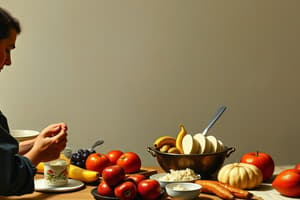Podcast
Questions and Answers
What are biological hazards?
What are biological hazards?
- Viruses
- Poisons
- Bacteria
- All of the above (correct)
How many people get sick a year from improper food handling?
How many people get sick a year from improper food handling?
more than 75 million
You can see when people have a bad immune system.
You can see when people have a bad immune system.
False (B)
How often does bacteria double?
How often does bacteria double?
What are chemical hazards?
What are chemical hazards?
What are physical hazards?
What are physical hazards?
What are the three categories of potential hazards to food safety?
What are the three categories of potential hazards to food safety?
Are gloves required for food preparation by state law?
Are gloves required for food preparation by state law?
If I am sick, can I still work?
If I am sick, can I still work?
What does FIFO stand for?
What does FIFO stand for?
Which of the following is not an example of dry goods?
Which of the following is not an example of dry goods?
Can hot food be placed directly into the refrigerator or freezer?
Can hot food be placed directly into the refrigerator or freezer?
What is one piece of equipment every food establishment needs to ensure that food is cooked safely?
What is one piece of equipment every food establishment needs to ensure that food is cooked safely?
When should thermometers be calibrated?
When should thermometers be calibrated?
There are specific methods to measuring temperature readings of packaged and unpackaged food.
There are specific methods to measuring temperature readings of packaged and unpackaged food.
Which of the following is an improper method of serving food?
Which of the following is an improper method of serving food?
Flashcards are hidden until you start studying
Study Notes
Biological Hazards
- Biological hazards include pathogens such as viruses, parasites, fungi, and bacteria like Staphylococcus aureus.
- More than 75 million people get sick annually from improper food handling.
Health and Immune Systems
- It is false that visible signs can indicate a person with a weak immune system.
Bacterial Growth
- Bacteria can double in number every 20 minutes, increasing food safety risks.
Chemical Hazards
- Chemical hazards involve food service chemicals used incorrectly, including cleaners, sanitizers, and toxic metals.
Physical Hazards
- Physical hazards consist of foreign objects in food, such as hair, dirt, bandages, and broken glass.
Categories of Hazards
- Potential hazards to food safety fall into three categories: Biological, Chemical, and Physical.
Understanding Potential Hazards
- Hazards can be classified as pathogens, chemicals, or foreign objects.
Glove Use Requirement
- There is no state requirement to wear gloves for food preparation, but proper handwashing is essential.
Working While Sick
- If an employee is sick, they must be sent home if exhibiting symptoms like vomiting, diarrhea, or jaundice.
FIFO Method
- FIFO (First In, First Out) indicates that food items that arrive first should be used first to maintain freshness.
Identifying Dry Goods
- Fresh or frozen ground beef is not considered a dry good; examples of dry goods include cereal, dry pasta, and soup crackers.
Storing Hot Food
- Hot food must cool down to proper temperatures before being stored in the refrigerator or freezer.
Essential Equipment
- A bi-metallic stemmed thermometer is crucial for every food establishment to ensure food is cooked safely.
Thermometer Calibration
- Thermometers should be calibrated when measuring temperatures at both high and low extremes.
Measuring Food Temperature
- There are specific methods for accurately measuring temperature in both packaged and unpackaged food.
Serving Food Correctly
- Improper serving methods include holding plates from the sides, using thumbs on the surface, and eating while serving; however, holding plates from the bottom is acceptable.
Studying That Suits You
Use AI to generate personalized quizzes and flashcards to suit your learning preferences.




